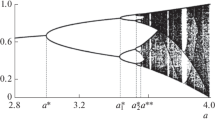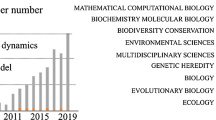Abstract
Populations of voles, and lemmings of the Northern hemisphere exhibit cyclic fluctuations with a cycle of three to four years. Krebs et al. presented evidence that the cycles are driven by changes in the genotypic structure of the population [9]. Incorporating some of their hypotheses we present a mathematical model of a one locus two allele population with density dependent selection and assuming a slow selection hypothesis, the existence of periodic solutions is proved. These solutions arise by Hopf bifurcation in δ 1/¦β1¦, the ratio of the residual death and birth rates of the density sensitive homozygote.
Similar content being viewed by others
References
Asmussen, M.: Regular and chaotic cycling in models of ecological genetics. Theoret. Population Biology 16, 172–190 (1979)
Aronson, D., Weinberger, H.: Non linear diffusion in population genetics, combustion, and nerve propagation. In: P. D. E. and related topics (Goldstein, J. A., ed.). Lecture notes in mathematics. Vol. 446, pp. 5–49. Berlin, Heidelberg, New York: Springer 1975
Chitty, D.: The natural selection of self-regulatory behaviour in animal populations. In: Populations regulation (Tamarin, R., ed.). Dowden Hutchinson and Ross Inc. 1978
Elton, C.: Voles, lemmings, and mice. Oxford University, Clarendon Press 1942
Fife, P.: Mathematical aspects of reacting and diffusing systems. Lecture notes in biomathematics. Vol. 28. Berlin, Heidelberg, New York: Springer 1979
Hoppensteadt, F.: Properties of solutions of ordinary differential equations with a small parameter. Comm. Pure Appl. Math. 24, 807–840 (1971)
Hunt, F.: On the persistence of spatially homogeneous solutions of a population genetics model with slow selection. Mathemat. Biosci. 52, 185–206 (1980)
Krebs, C.: Dispersal spacing behaviour and genetics in relation to population fluctuations in the vole microtus townsendii. Fortschr. Zool. 25, 61–77 (1979)
Krebs, C., Gaines, M., Keller, B., Myers, J., Tamarin, R.: Population cycles in small rodents. In: Population regulation (Tamarin, R., ed.). Dowden Hutchinson and Ross Inc. 1978
Nagylaki, T.: Natural selection in one and two locus systems. Lecture notes in biomathematics. Vol. 15. Berlin-Heidelberg-New York: Springer 1977
Oster, G., Ipaktchi, A., Rocklin, S.: Phenotypic structure and bifurcation behaviour of population models. Theoret. Population Biology 10, 365–382 (1976)
Pimentel, D.: Animal population regulation by the genetic feedback mechanism. In: Population regulation (Tamarin, R., ed.). Dowden Hutchinson and Ross Inc. 1978
Poulsen, E. T.: Model for population regulation with density and frequency dependent selection. J. Math. Biol. 8, 325–343 (1979)
Author information
Authors and Affiliations
Additional information
Partially supported by NSF Grant # MCS-8005777
Rights and permissions
About this article
Cite this article
Hunt, F. Regulation of population cycles by genetic feedback: Existence of periodic solutions of a mathematical model. J. Math. Biology 13, 271–282 (1982). https://doi.org/10.1007/BF00276064
Received:
Revised:
Issue Date:
DOI: https://doi.org/10.1007/BF00276064




